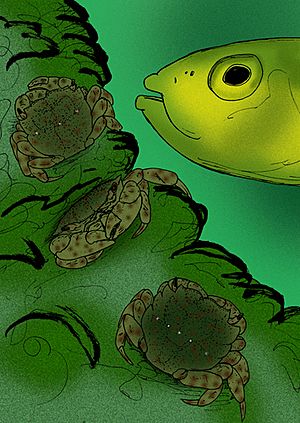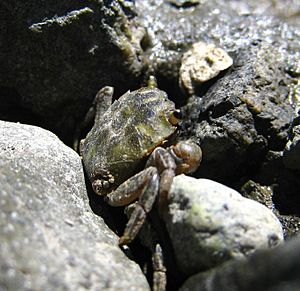Hemigrapsus estellinensis facts for kids
Quick facts for kids Hemigrapsus estellinensis |
|
|---|---|
 |
|
| artist's image | |
| Conservation status | |
| Scientific classification | |
| Kingdom: | |
| Phylum: | |
| Subphylum: | |
| Class: | |
| Order: | |
| Infraorder: | |
| Family: |
Varunidae
|
| Genus: |
Hemigrapsus
|
| Species: |
†H. estellinensis
|
| Binomial name | |
| Hemigrapsus estellinensis Creel, 1964
|
|
Hemigrapsus estellinensis was a type of crab that is now extinct. It used to live only in the Texas Panhandle in the United States. A scientist named Gordon C. Creel found it in 1962. Sadly, it was probably already gone before his discovery was even published in 1964. This happened because the special salt springs where it lived were changed by the United States Army Corps of Engineers.
This crab was related to crabs from the Pacific Ocean, like Hemigrapsus oregonensis. But H. estellinensis lived about 500 miles (800 km) inland. It lived in a very salty spring. You could tell it apart from its relatives by the spots on its back. Also, its legs were different sizes compared to other crabs in its family.
What Did H. estellinensis Look Like?

The H. estellinensis crab had a body shell, called a carapace, that looked like a rectangle. Its sides were almost straight. Male crabs had a carapace up to 0.73 inches (18.5 mm) long. Their carapace could be up to 0.87 inches (22 mm) wide. Female crabs had a carapace up to 0.67 inches (17 mm) long. Their carapace could also be up to 0.87 inches (22 mm) wide. The front corners of the carapace had three strong teeth on each side.
The main way to tell H. estellinensis apart from other crabs in its group was its spots. It had many rust-red spots on its "drab green" carapace. It also had two clear white spots near the ends of an H-shaped mark on its back. There was another spot between each of these white spots and the side of its body.
Its legs had bigger spots than its body shell. Both its claws, called chelipeds, and its walking legs were shorter than those of other related crabs. The crab's underside, including its abdomen, had no spots. Male crabs had a hairy patch on the bottom of their claws. This patch had special sensors, called chemoreceptors, that helped them sense chemicals.
Gordon Creel collected 6 male crabs and 10 female crabs. One male crab was the main example, called the holotype. All the others were extra examples, called paratypes. All 16 crabs are kept at the National Museum of Natural History. A few living crabs were taken to Wayland College. But they died within 17 hours for reasons no one knows. Two of the female crabs laid eggs before they died. One laid 3,000 eggs, and the other laid 8,000 eggs.
Where Did H. estellinensis Live?
H. estellinensis lived in the Estelline Salt Springs. These springs were east of the town of Estelline in Hall County, Texas. This was about 500 miles (800 km) away from the closest ocean. Before it became extinct, it was the only troglobitic crab in the contiguous United States. A troglobitic animal lives only in caves or underground places. It was "curious" that this crab lived so far from the ocean. Scientists think it was a "Pleistocene relic". This means it was a leftover species from a past ice age.
The springs originally had water with a salinity of 43‰. This means 43 parts per thousand of salt. This salty water flowed into the Prairie Dog Town Fork of the Red River. The salt came from Permian red beds (rock layers). This salt greatly affected the plants and animals living in the Red River. The spring flowed at about 3,000 US gallons (11,000 L) per minute. The pool was about 65 feet (20 m) wide at the surface. The surface was about 1,742.5 feet (531.1 m) above sea level. At a depth of 25 feet (7.6 m), the pool was only 20 feet (6.1 m) wide. It then got a little wider down to a depth of 120 feet (37 m). Below that, a 3-foot (0.91 m) wide opening led into a cave completely filled with water.
Why Did H. estellinensis Disappear?
The United States Army Corps of Engineers built a wall, called a dike, around the Estelline Salt Springs in January 1964. This dike reduced the amount of salt flowing into the Red River. It stopped about 240 short tons (220 t) of salt per day. Before the dike was built, the spring had many different living things. These included cyanobacteria like Oscillatoria and Lyngbya. There were also green algae like Ulva clathrata and U. intestinalis. Twenty different kinds of diatoms lived there too. Many invertebrates, including a type of barnacle, and one fish species, Cyprinodon rubrofluviatilis, also called the Red River pupfish, called it home.
After the dike was built, the springs became even saltier. Many species could not survive the change and became extinct. This included H. estellinensis and the undescribed barnacle. As early as December 1962, people tried to find more living H. estellinensis crabs but could not. It was likely extinct before Gordon Creel's description was even published in 1964.
The closest relative of H. estellinensis is the shore crab Hemigrapsus oregonensis. This crab lives along the coast of the Pacific Ocean. Most crabs in the Hemigrapsus group live only in the Pacific Ocean. However, Hemigrapsus affinis lives along the Atlantic coasts of South America. And Hemigrapsus sanguineus has been brought from its home in East Asia to the Atlantic coast of the United States and parts of Europe.
- Estelline Salt Springs: 34°32′51″N 100°25′20″W / 34.54750°N 100.42222°W


